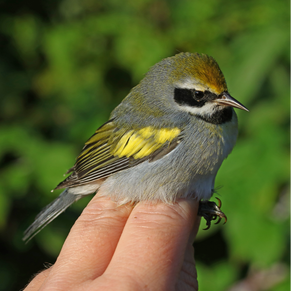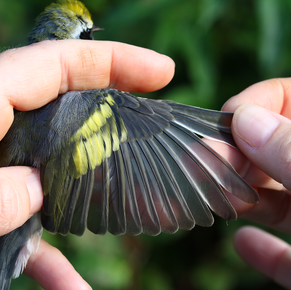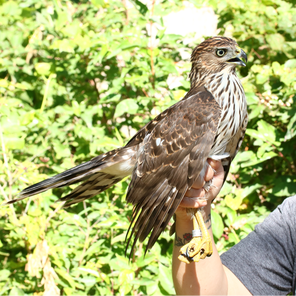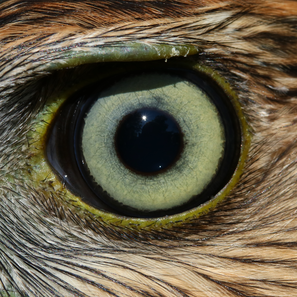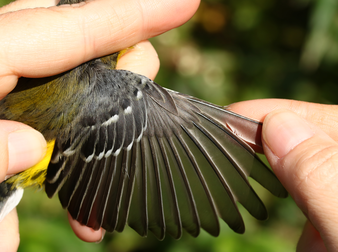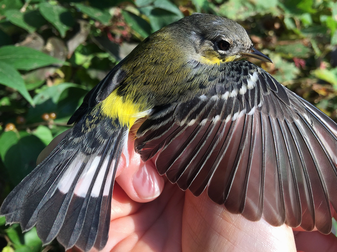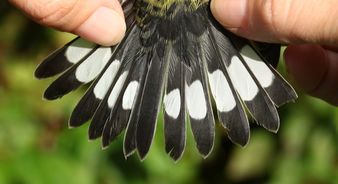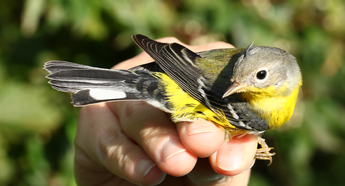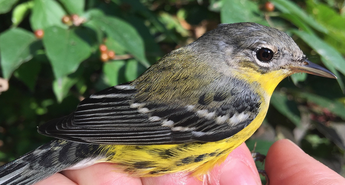Enjoying our blogs?Your support helps BSBO continue to develop and deliver educational content throughout the year.
|
|
Within a short period of time, we quickly went from banding 20-30 birds a day, to processing 70-100 birds daily. However, with recent hot weather (temps in the 80’s over the past week) our numbers have dropped back down to about 40-50 birds daily. By the end of this week, with temps cooling down and winds coming out of the north, we should really start to see some good numbers as we head into the heaviest part of migration. Our warbler count is up to 24 species now and we have begun to see more diversity in migrants. But the largest bumps in numbers have come from Swainson’s Thrush and Blackpoll Warbler (two of our most dominant fall species), catching (so far) anywhere from 15-40 of each species a day. At this point, Baltimore Orioles and most of the flycatchers have completely left the area, and even though they SHOULD be gone, we have caught a few late Prothonotary Warblers. Along with new thrushes and warblers coming in, we have also banded a few Ruby-crowned Kinglets and a (gorgeous) White-throated Sparrow, and have heard Golden-crowned Kinglet and Red-breasted Nuthatch in the station (sure signs of fall). There have also been a few great surprise captures over the past couple of weeks including a hatching-year (HY) male Golden-winged Warbler. While the mist net mesh size we use is suited best for smaller passerines, we do on occasion catch larger birds (if we can get to them fast enough before they bounce out of the net). Case in point, we were at the nets just at the right time to capture an HY female Cooper’s Hawk this past week. Aging accipiters is pretty straightforward. A yellow eye, brown back, and white chest with vertical brown streaks distinguish this bird as an HY (versus a red eye, blue-gray back, and horizontal orange streaking in an adult). While there is some overlap in measurements between the sexes, determining female from male is also pretty easy, with females being significantly larger than males (this female weighed in at 457 grams). Not necessarily a surprise capture (as we banded a significant amount of them) Magnolia Warbler is a great starter species for learning how to age and sex other Setophaga warblers. First, look for a molt limit in the wing to age the bird. In the bird pictured on the left, there is an obvious difference between the retained narrow, brown-gray juvenal primary coverts (p-covs) and alula, and the newer, black greater coverts (gr-covs); making this bird an HY. The after-hatching-year (AHY)(adult) bird pictured on the right lacks a molt limit, showing similarly colored gr-covs and alula feathers, and wide, dark gray p-covs. Also note the AHY's wide, truncate tail feathers compared to the HY's relatively narrow tail feathers in the lower middle picture. After age is determined, figuring out the sex pretty much comes down to three things: streaks, upertail coverts, and white in the tail. Even in both age groups (HY and AHY), males will typically show more of each of these features than females (ie. more prominent black streaks on the sides, breast, and back, more black in the upertail coverts, and more white in the tail). Looking at our two birds, you can see that the sides have distinct black streaks (especially on the AHY), the upertail coverts are overwhelmingly black, and there are large, similarly sized spots of white throughout the tail feathers (except the center two). Also note the AHY why has some flecks of black in the face. Combined, these three features confidently make the right HY and left AHY both males.
1 Comment
Bill Ringer
9/27/2017 10:44:01 am
I am so pleased that the banding team is AGAIN publishing the banding blog it is SOOOO interesting and educational. I spent 3 days with your banding team and loved every second of it.
Reply
Your comment will be posted after it is approved.
Leave a Reply. |
AuthorsRyan Jacob, Ashli Gorbet, Mark Shieldcastle ABOUT THE
|
